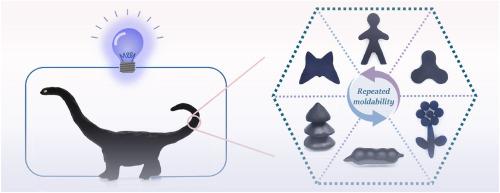Self-healing and repeatedly moldable plasticine-like electrodes
IF 4.1
2区 化学
Q2 POLYMER SCIENCE
引用次数: 0
Abstract
Combining the re-moldable and self-healing properties of plasticine with energy storage can yield a novel electrode with excellent shape adaptability, ideal for use in portable and wearable electronics. Here, a plasticine-like supercapacitor electrode material is designed and prepared by incorporating the electrochemically active polypyrrole, ionic liquid, and carbon nanotube into the silicone rubber matrix. Polypyrrole, ionic liquid, and carbon nanotube synergistically regulate the cross-linking degree of silicone rubber, producing a moderately cured silicone rubber matrix that binds the components together and provides plasticity and healing ability. The plasticine-like electrode material shows high specific capacitance and good cycling stability, attributed to the good electrochemical activity of polypyrrole, effective charge transport path formed by carbon nanotube and ionic liquid, and the soft skeleton provided by silicone rubber. Moreover, it can achieve real-time and reproducible healing through mechanical kneading, with both mechanical and electrochemical properties restoring to their initial state. The plasticine-like electrode materials, with their excellent plasticity, self-healing ability, and strong electrochemical performance, hold significant potential for a wide range of applications and can inspire the development of similar materials.


求助全文
约1分钟内获得全文
求助全文
来源期刊

Polymer
化学-高分子科学
CiteScore
7.90
自引率
8.70%
发文量
959
审稿时长
32 days
期刊介绍:
Polymer is an interdisciplinary journal dedicated to publishing innovative and significant advances in Polymer Physics, Chemistry and Technology. We welcome submissions on polymer hybrids, nanocomposites, characterisation and self-assembly. Polymer also publishes work on the technological application of polymers in energy and optoelectronics.
The main scope is covered but not limited to the following core areas:
Polymer Materials
Nanocomposites and hybrid nanomaterials
Polymer blends, films, fibres, networks and porous materials
Physical Characterization
Characterisation, modelling and simulation* of molecular and materials properties in bulk, solution, and thin films
Polymer Engineering
Advanced multiscale processing methods
Polymer Synthesis, Modification and Self-assembly
Including designer polymer architectures, mechanisms and kinetics, and supramolecular polymerization
Technological Applications
Polymers for energy generation and storage
Polymer membranes for separation technology
Polymers for opto- and microelectronics.
 求助内容:
求助内容: 应助结果提醒方式:
应助结果提醒方式:


